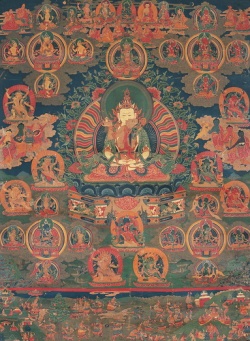Analogy of Falling Asleep
Buddha said that every action we perform leaves an imprint on our very subtle mind, and each imprint eventually gives rise to its own effect. Our mind is like a field, and performing actions is like sowing seeds in that field. Virtuous, or positive, actions sow seeds of future happiness and non-virtuous, or negative, actions sow seeds of future suffering. The seeds we have sown in the past remain dormant until the conditions necessary for their ripening come together. In some cases this can be many lifetimes after the original action was performed.
The seeds that ripen when we die are very important because they determine what kind of rebirth we shall take. Which particular seed ripens at death depends upon the state of mind in which we die. If we die with a peaceful mind, this will stimulate a virtuous seed and we shall experience a fortunate rebirth; but if we die with a disturbed mind, in a state of anger, say, this will stimulate a non-virtuous seed and we shall experience an unfortunate rebirth. This is similar to the way in which nightmares arise from our being in an agitated state just before falling asleep.
The Analogy
The analogy of falling asleep is not accidental, for the process of sleep, dreaming, and waking closely resembles the process of death, intermediate state, and rebirth. As we fall asleep, the inner energy winds that support our gross minds gather and dissolve inwards. As a result our mind becomes progressively more and more subtle until it transforms into the very subtle mind of the clear light of sleep. While the clear light of sleep is manifest we experience deep sleep, and to others we resemble a person who has died. When it ends, our mind becomes gradually more and more gross and we pass through the various levels of the dream state. Finally, our normal powers of memory and mental control are restored and we wake up. When this happens our dream world disappears and the ordinary world of our waking state appears.
A very similar process occurs when we die. As we die, our energy winds dissolve inwards and our mind becomes progressively more and more subtle until the very subtle mind of the clear light of death manifests. The experience of the clear light of death is very similar to the experience of deep sleep. After the clear light of death has ceased we experience the stages of the intermediate state, or `bardo’ in Tibetan, which is a dream-like state that occurs between death and rebirth. After a few days or weeks the intermediate state ends and we take rebirth. Just as when we wake from sleep the dream world disappears and we perceive the world of the waking state, so when we take rebirth the appearances of the intermediate state cease and the world of our next life appears.
The only significant difference between the process of sleep, dreaming, and waking and the process of death, intermediate state, and rebirth is that after the clear light of sleep has ceased the connection between our mind and our present body remains intact, whereas after the clear light of death this is broken.
